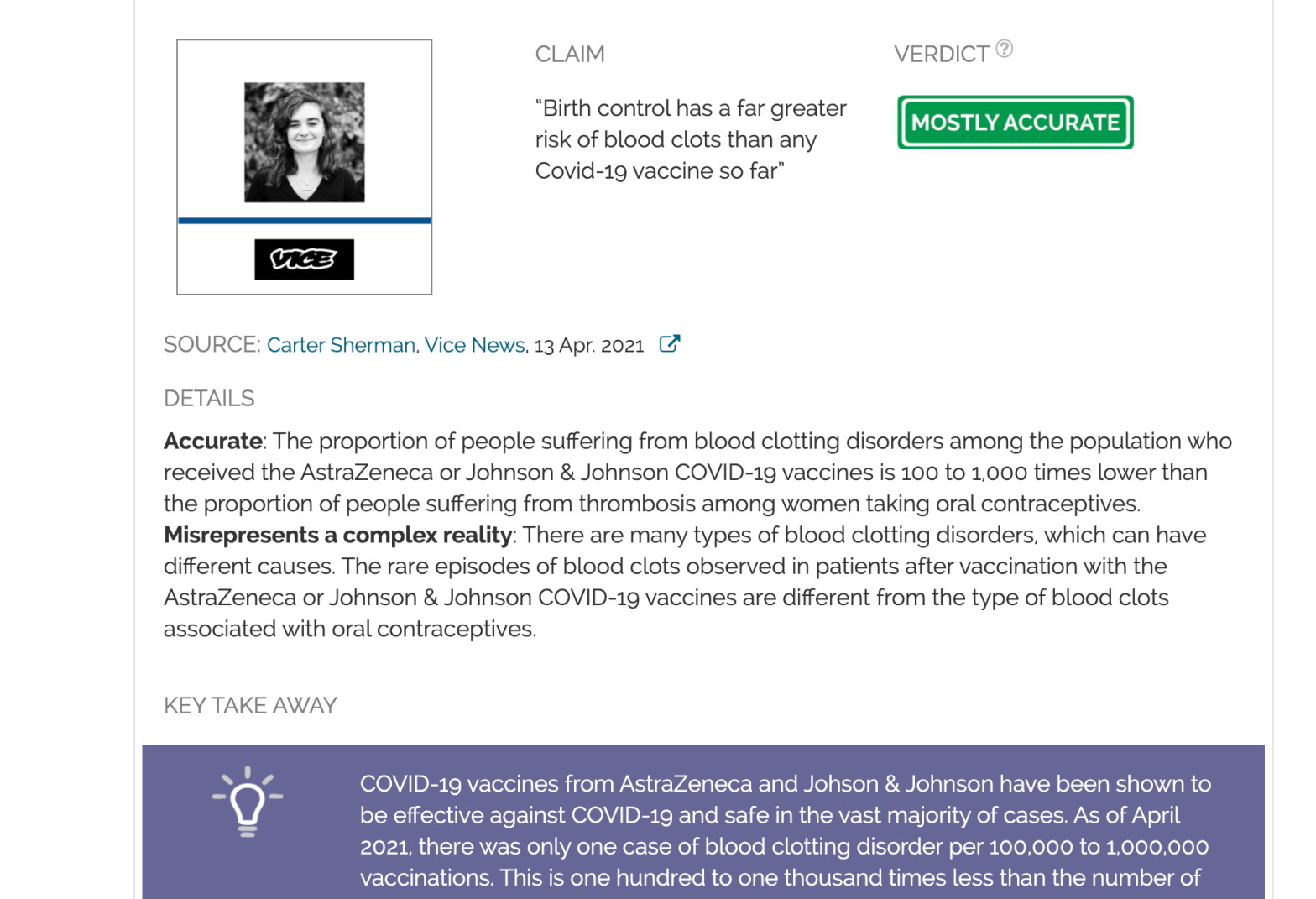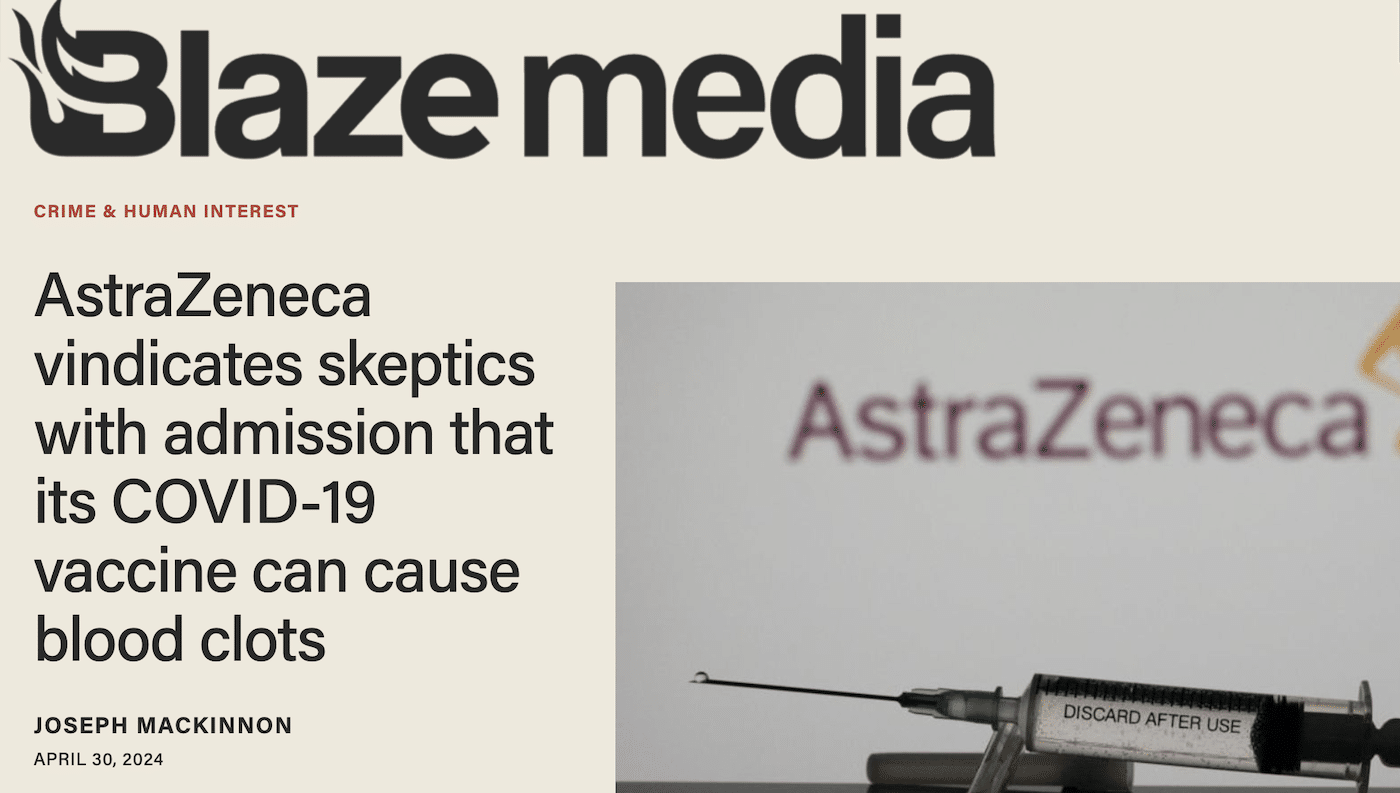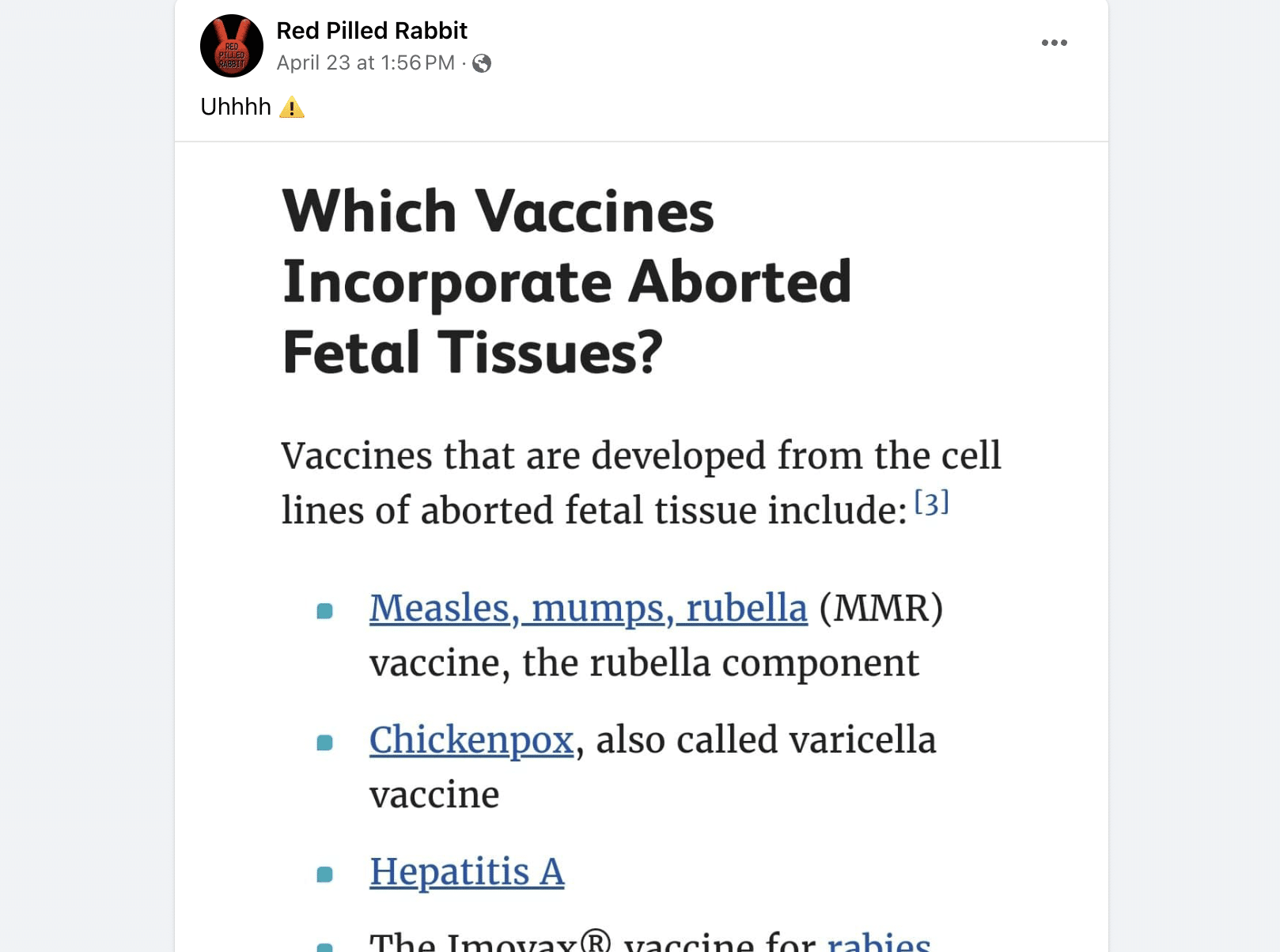- Health
Oral contraceptives have a bigger risk factor for blood clot formation than the AstraZeneca and Johnson & Johnson COVID-19 vaccines
Key takeaway
COVID-19 vaccines from AstraZeneca and Johnson & Johnson are effective against COVID-19 and safe in the vast majority of cases. As of April 2021, there was only one case of a blood clotting disorder per 100,000 to 1,000,000 vaccinations. This is one hundred to one thousand times less than the number of blood clotting disorders associated with the use of oral contraceptives within a year. However, it is important to note that oral contraceptives and the AstraZeneca and Johnson & Johnson vaccines are associated with different types of blood clotting disorders and thus cannot be directly compared.
Reviewed content

Verdict:
Claim:
“Birth control has a far greater risk of blood clots than any Covid-19 vaccine so far”
Verdict detail
Accurate: The proportion of people suffering from blood clotting disorders among the population who received the AstraZeneca or Johnson & Johnson COVID-19 vaccines is 100 to 1,000 times lower than the proportion of women suffering from thrombosis who take oral contraceptives.
Misrepresents a complex reality: There are many types of blood clotting disorders, which can have different causes. The rare episodes of blood clots observed in patients after vaccination with the AstraZeneca or Johnson & Johnson COVID-19 vaccines are different from the type of blood clots associated with oral contraceptives.
Full Claim
“Birth control has a far greater risk of blood clots than any Covid-19 vaccine so far”; “the J&J vaccine is safer than the [oral] birth control”.
Review
Several COVID-19 vaccines are in use after large clinical trials showed their safety and efficacy. However, reports of blood clots among people who received a COVID-19 vaccine from Johnson & Johnson or from AstraZeneca led health agencies in various countries to suspect a possible association between the vaccine and the blood clots. These rare events seem to appear preferentially among younger vaccine recipients. Although a causal link has not been formally demonstrated so far, several governments temporarily suspended or cancelled the roll out.
Posts proliferated on social media platforms comparing the prevalence of blood clots between the population who received the aforementioned COVID-19 vaccines and the population that uses oral contraceptives. The posts concluded by claiming that the vaccines were safer than oral contraceptives. Examples can be seen here and here that together received more than 50,000 interactions according to CrowdTangle, a social media analytics tool.
Based on data available as of April 2021, this claim appears to be mostly accurate. There are much fewer cases of blood clots occurring after people received the COVID-19 vaccines than when using oral contraceptives.
Thrombosis is the coagulation of blood within the vessels to form a clot. When this occurs, the blood circulation in the area through which the blood vessel runs decreases. Thrombosis can be particularly dangerous if it occurs in the brain or in the arteries feeding the heart because they can cause strokes and heart attacks.
According to the New York Times on 14 April 2021, the European Medicines Agency (EMA) reported 222 cases of thrombosis among people who received the AstraZeneca COVID-19 vaccine, 18 of which were fatal. On 16 April 2021, the World Health Organization released a statement that the prevalence of thrombosis was 1 case for 250,000 AstraZeneca COVID-19 vaccine recipients in the UK and 1 case for 100,000 per recipient in the European Union.
As far as the Johnson & Johnson COVID-19 vaccine is concerned, 8 cases of thrombosis were reported for 7.4 million people who received the shot, yielding a ratio of 1 case per 925,000 vaccines administered. However, it ought to be emphasized that the data cannot be directly compared between the two vaccines because their use began at different times and the vaccines were deployed in different regions. The Johnson & Johnson vaccine rollout began later and its use has so far been largely confined to the U.S., whereas the data on the AstraZeneca vaccine were collected in the European Union and the U.K.
By looking at the prevalence of blood clots, we can understand why a possible association between thrombosis and those vaccines wasn’t detected during the initial clinical trials. The Phase III clinical trials enrolled[1] between 8,000 and 40,000 volunteers. Contrast this number with the prevalence of thrombosis, which is so rare that the trials would have needed to recruit 200,000 to 500,000 volunteers to detect one case of thrombosis in the AstraZeneca trial and more than 1.8 million people in the Johnson & Johnson trial.
How do these ratios compare with the ratio of thrombotic events among women taking oral contraceptives? Oral contraceptives increase the risk of thrombosis because the progestin and estrogen in them change the level of blood coagulation factors, which are proteins involved in the process of blood clotting and important for stopping bleeding[2]. Approximately 1 in 1,000 women using oral contraceptives develop blood clots in a given year, about four times more than women who don’t use these contraceptives. The numbers may vary depending on the hormone concentration of oral contraceptives. Therefore, it is indeed accurate to claim that the prevalence of blood clots associated with the Johnson & Johnson and AstraZeneca COVID-19 vaccines is much lower than the incidence of blood clots associated with oral contraceptives.
However, this comparison is limited because the type of thrombosis associated with oral contraceptives differs from that observed after vaccination. As mentioned above, oral contraceptives may increase the likelihood of thrombosis by altering the level of coagulation factors circulating in the blood. The blood clots associated with oral contraceptives are a common type of thrombosis called deep vein thrombosis, which usually occurs in the legs.
By contrast, the blood clots reported following these vaccinations are a rarer type known as cerebral venous sinus thromboembolism. They often form in the brain and are associated with a low level of circulating platelets. Platelets are a type of blood cell with a central role in blood clotting. The low level of platelets, or thrombocytopenia, associated with this disorder may be due to the fact that the platelets were used to form the aberrant blood clots.
In fact, the reported cases of thrombosis are more similar to what may happen in patients who received the blood thinner heparin. In some cases, the injection of heparin causes an immune reaction where the patient’s antibodies bind to a molecule called platelet factor IV released by platelets and trigger the blood coagulation, leading to more blood clots than fewer and producing the opposite result expected from a blood thinner[3]. People who suffered from thrombosis after receiving the AstraZeneca COVID-19 vaccine also had antibodies against that platelet factor IV suggesting that the vaccine may induce a reaction similar to the heparin-induced thrombocytopenia in some very rare cases[4].
Furthermore, the populations whose risk of blood clots are compared are very different. The population that received the vaccines comprise both men and women of various ages, whereas the population taking oral contraceptives by default comprises only women within a certain age range. Therefore, while numerically accurate, the comparison between the AstraZeneca and Johnson & Johnson COVID-19 vaccines and oral contraceptives is not completely fair.
In summary, the proportion of people who suffered from a blood clotting disorder following vaccination with the AstraZeneca or Johnson & Johnson vaccine is very low and is much lower than the proportion of thrombosis among women taking oral contraceptives. However, the type of thrombosis and the mechanism leading to thrombosis are different, which limits the fairness of this comparison.
REFERENCES
- 1 – Voysey et al. (2021) Safety and efficacy of the ChAdOx1 nCoV-19 vaccine (AZD1222) against SARS-CoV-2: an interim analysis of four randomised controlled trials in Brazil, South Africa, and the UK. The Lancet.
- 2 – Bonnar (1987) Coagulation effects of oral contraception. American Journal of Obstetrics and Gynecology.
- 3 – Linkins (2015) Heparin induced thrombocytopenia. The British Medical Journal.
- 4 – Scully et al. (2021) Pathologic Antibodies to Platelet Factor 4 after ChAdOx1 nCoV-19 Vaccination. The New England Journal of Medicine.



